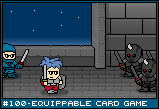| Three Hundred |
| - Index Page |
| - About... |
| - By Year |
| Collections |
| - Comp-Grid |
| - Procedural |
| - Tactics |
| - Tiny Crawl |
| - Misc |
| Previous | Mechanic #100 | Next |
|
![[road1.png]](set05/img/entry100-road1.png)
This is really a very simple mechanic, so before I get to the how, let's start with the why. The above image is an AMD version of [#023 - The Long Road]. The premise is that it is a turn based, side scrolling beat-em up. Unlike [#023 - The Long Road], however, there are only two planes (instead of five) in this example. Ideally, I'd like to lower it to even a single plane - meaning that the player's character will only ever engage, at most, two enemies (front and back) at a time. This reduces the tactical complexity of the playing field to the point where the best course of action is always obvious, available, and unsurprising. If you've ever played the first Dragon Quest game, which is the only JRPG that I'm aware of in which you only fight one enemy at a time in random battles, you understand how this simplicity makes for a rather unexciting experience. Some games combat tactically obvious scenarios by limiting one's ability to take the best action every turn. For instance, in roguelikes, its not uncommon for particularly powerful items to be limited use. In collectible card games, the randomness of acquiring cards and them being one use means that you have to constantly adjust to an ever changing situation. Metal Gear Acid (and its infinitely superior sequel) manage to combine collectible card games with a tactical experience. As such, the game has great replayability due to how completely different the experience is simply by altering your deck a bit.
I'm taking a page out of Acid's book and providing something which is both a collectible card game and a tactical experience. Cards represent specific action, but may also be discarded to perform basic actions, like walking or attacking. The rules are as follows:
Not particularly complicated and fairly similar to Acid's approach. I threw in the ability to do basic attacks and boost your attack/movement through more discards to avoid those situations in Acid where you could fight back while you waited multiple turns for a weapon to be drawn.
![[cards1.png]](set05/img/entry100-cards1.png) The twist here is that you do not decide what cards are in your deck directly. Instead, each equippable item comes with specific cards that are added to your deck on your behalf. Some cards are only available in certain circumstances (like wearing the Happy Suit with the Happy Shield, or being a Warrior while equipping the Great Axe of Happy). Roughly half your deck is decided for you based on your class and equipment. The other half is your own "inventory" deck.
You can have as many cards or as few cards in your deck as you'd like. Your equipment is guaranteed to have X number of cards in it, even if those cards are just simple attack or movement abilities. Your inventory deck is dependent on what you are carrying in your inventory, but you are not obligated to add any cards to it. If you have an item, like a potion stack, that you sell, the cards are simply removed from your inventory deck. When you add a new inventory item, you decide then which cards to add. This all happens between levels or in towns. You are stuck with one deck readout for an entire dungeon floor. Any inventory items you pick up during a stage are not available for use until you move to the next floor. Plan accordingly.
Your companions operate in a similar manner to the player, gameplay-wise. However, their deck is set and cannot be changed. In addition, they have fewer cards, both in their deck and in their hand each turn. For instance, a mage bodyguard may only have a dozen cards in his deck and can have no more than three cards in his hand at a time. Companions are meant to support the player, but not intended to be customized or to replace him.
|
